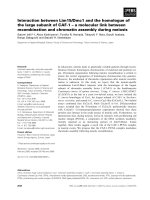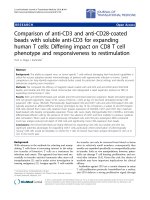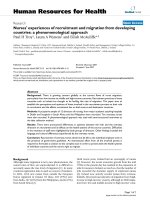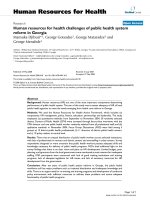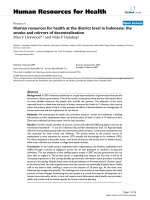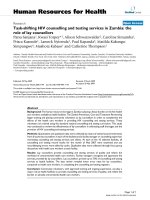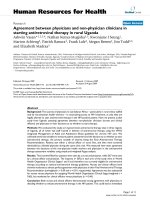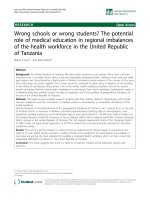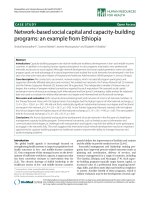Báo cáo sinh học: "Comparison between 68Ga-bombesin (68Ga-BZH3) and the cRGD tetramer 68Ga-RGD4 studies in an experimental nude rat model with a neuroendocrine pancreatic tumor cell line" ppt
Bạn đang xem bản rút gọn của tài liệu. Xem và tải ngay bản đầy đủ của tài liệu tại đây (855.56 KB, 23 trang )
This Provisional PDF corresponds to the article as it appeared upon acceptance. Fully formatted
PDF and full text (HTML) versions will be made available soon.
Comparison between 68Ga-bombesin (68Ga-BZH3) and the cRGD tetramer
68Ga-RGD4 studies in an experimental nude rat model with a neuroendocrine
pancreatic tumor cell line
EJNMMI Research 2011, 1:34 doi:10.1186/2191-219X-1-34
Caixia Cheng ()
Leyun Pan ()
Antonia Dimitrakopoulou-Strauss ()
Martin Schafer ()
Carmen Wangler ()
Bjorn Wangler ()
Uwe Haberkorn ()
Ludwig G Strauss ()
ISSN 2191-219X
Article type Original research
Submission date 28 July 2011
Acceptance date 13 December 2011
Publication date 13 December 2011
Article URL />This peer-reviewed article was published immediately upon acceptance. It can be downloaded,
printed and distributed freely for any purposes (see copyright notice below).
For information about publishing your research in EJNMMI Research go to
/>For information about other SpringerOpen publications go to
EJNMMI Research
© 2011 Cheng et al. ; licensee Springer.
This is an open access article distributed under the terms of the Creative Commons Attribution License ( />which permits unrestricted use, distribution, and reproduction in any medium, provided the original work is properly cited.
1
Comparison between
68
Ga-bombesin (
68
Ga-BZH3) and the cRGD
tetramer
68
Ga-RGD
4
studies in an experimental nude rat model with a
neuroendocrine pancreatic tumor cell line
Caixia Cheng
*
1
, Leyun Pan
1
, Antonia Dimitrakopoulou-Strauss
1
, Martin Schäfer
2
, Carmen
Wängler
3
, Björn Wängler
3
, Uwe Haberkorn
1
and Ludwig G Strauss
1
1
Clinical Cooperation Unit Nuclear Medicine, German Cancer Research Center, Heidelberg, Germany
2
Department of Radiopharmaceutical Chemistry, German Cancer Research Center, Heidelberg,
Germany
3
University Hospital Munich, Department of Nuclear Medicine, Ludwig Maximilians-University
Munich, Munich, Germany
*Corresponding author:
Email addresses:
LP:
ADS:
MS:
CW:
BW:
UH:
LGS:
Abstract
Objectives: Receptor scintigraphy gains more interest for diagnosis and treatment of
tumors, in particular for neuroendocrine tumors (NET). We used a pan-Bombesin analog,
the peptide DOTA-PEG
2
-[D-tyr
6
, β-Ala
11
, Thi
13
, Nle
14
] BN(6-14) amide (BZH3). BZH3
binds to at least three receptor subtypes: the BB1 (Neuromedin B), BB2
(Gastrin-releasing peptide, GRP), and BB3. Imaging of ανβ3 integrin expression playing
an important role in angiogenesis and metastasis was accomplished with a
68
Ga-RGD
tetramer. The purpose of this study was to investigate the kinetics and to compare both
tracers in an experimental NET cell line.
Methods: This study comprised nine nude rats inoculated with the pancreatic tumor cell
line AR42J. Dynamic positron emission tomography (PET) scans using
68
Ga-BZH3 and
68
Ga-RGD tetramer were performed (
68
Ga-RGD tetramer: n = 4,
68
Ga-BZH3: n = 5).
Standardized uptake values (SUVs) were calculated, and a two-tissue compartmental
learning-machine model (calculation of K1 − k4 vessel density (VB) and receptor binding
potential (RBP)) as well as a non-compartmental model based on the fractal dimension
was used for quantitative analysis of both tracers. Multivariate analysis was used to
2
evaluate the kinetic data.
Results: The PET kinetic parameters showed significant differences when individual
parameters were compared between groups. Significant differences were found in FD,
VB, K1, and RBP (p = 0.0275, 0.05, 0.05, and 0.0275 respectively). The 56- to 60-min
SUV for
68
Ga-BZH3, with a range of 0.86 to 1.29 (median, 1.19) was higher than the
corresponding value for the
68
Ga-RGD tetramer, with a range of 0.78 to 1.31 (median,
0.99). Furthermore, FD, VB, K1, and RBP for
68
Ga-BZH3 were generally higher than the
corresponding values for the
68
Ga-RGD tetramer, whereas k3 was slightly higher for
68
Ga-RGD tetramer.
Conclusions: As a parameter that reflects receptor binding, the increase of K1 for
68
Ga-BZH3 indicated higher expression of bombesin receptors than that of the ανβ3
integrin in neuroendocrine tumors.
68
Ga-BZH3 seems better suited for diagnosis of NETs
owing to higher global tracer uptake.
Keywords:
68
Ga-bombesin;
68
Ga-RGD tetramer; PET; kinetic modeling, neuroendocrine
tumors.
Introduction
During the past decade, the application of radiolabeled somatostatin analogs in nuclear
medicine for diagnostics and therapy of neuroendocrine tumors has achieved success and
stimulated the research in receptor targeting of additional tumor types [1]. Positron
emission tomography (PET) is the most efficient imaging method in nuclear medicine
because of its option of an absolute activity determination, its better contrast resolution,
and its higher detection efficiency compared with conventional γ-cameras. PET with
18
F-fluorodeoxyglucose (
18
F-FDG) is frequently used for oncologic applications to assess
tissue viability, thereby gain the staging and therapy monitoring by qualitative analysis of
SUV and quantitative evaluation based on the compartmental analysis of kinetic
parameters [2]. However, not all tumors are
18
F-FDG avid, and in particular treated
tumorous lesions may demonstrate a low fluorodeoxyglucose (FDG) uptake and can
therefore not be delineated using FDG. Therefore, new specific tracers are needed to
enhance the sensitivity and specificity of PET. One approach is to study the expression of
receptors to gain specificity. Experimental data demonstrated enhanced bombesin (BN)
receptors in neuroendocrine tumors (NETs) [3–5].
Bombesin is an amphibian neuropeptide of 14 amino acids that shows a high affinity for
the human gastrin-releasing peptide receptor (GRP-r, also known as BB
2
), which is
overexpressed on several types of cancer. In addition, for the neuromedin B (BB
1
) and the
bombesin receptor subtype (BB
3
), bombesin also shows a high affinity. Thus,
radiolabeled BN and BN analogs may prove to be specific tracers for diagnostic and
3
therapeutic targeting of GRP-r-positive tumors in nuclear medicine [6–13]. We have
reported
68
Ga-labeled bombesin may be helpful for diagnostic reasons in a subgroup of
patients with GIST and recurrent gliomas [14–15].
The expression of GRP receptor in AR42J cell line has been reported by other groups
[16–17]. So far, the expression of integrin ανβ3 in AR42J cell line has not been reported
yet. However, the integrin ανβ3 plays an important role in angiogenesis and tumor
metastasis. It is expressed on activated endothelial cells as well as some tumor cells [18].
Therefore, it is a promising imaging target as a potential surrogate parameter of
angiogenic activity.
The
68
Ga-RGD tetramer
68
Ga-RGD
4
is a specific tracer for the integrin ανβ3 [19]. Herein,
dynamic PET studies with
68
Ga-Bombesin were performed in AR42J tumor-bearing mice
to investigate the impact of complementary receptor scintigraphy on diagnosis and the
potential of a radionuclide treatment. Furthermore, dynamic
68
Ga-RGD
4
studies were
performed for comparison.
Materials and methods
Synthesis of RGD
4
Resins for peptide synthesis, coupling reagents, and Fmoc-protected amino acids were
purchased from NovaBiochem. For analytical and semi-preparative high-performance
liquid chromatography (HPLC), an Agilent 1200 system was used. The columns used for
chromatography were a Chromolith Performance (RP-18e, 100 to 4.6 mm, Merck,
Germany) and a Chromolith (RP-18e, 100–10 mm, Merck, Darmstadt, Germany)
column, operated with flows of 4 and 8 mL/min, respectively. ESI and MALDI were
obtained with a Finnigan MAT95Q and a Bruker Daltonics Microflex (Bruker Daltonics,
Bremen, Germany), respectively.
The compound (DOTA-comprising maleimide tetramer (DOTA-Mal
4
)) was synthesized
on solid support by standard Fmoc solid-phase peptide synthesis as described by Wellings
et al. [20] on a standard rink amide resin. After coupling of Fmoc-Lys(Mtt)-OH to this
resin (100 µmol), the Mtt-protecting group was removed by successive incubation with
1.75% TFA in DCM followed by coupling of tris-tBu-DOTA and Fmoc-Lys(Fmoc)-OH
under standard conditions. After removal of both lysine Fmoc protecting groups using
deprotection times of twice 2 min and twice 5 min, Fmoc-Lys(Fmoc)-OH was coupled
twice. After removal of all four lysine Fmoc protecting groups using deprotection times
of twice 2 min and twice 10 min, maleimidobutyric acid was coupled applying the
standard protocol. The product was cleaved from the solid support and deprotected using
a mixture of TFA (trifluoroacetic acid)/TIS (triisopropylsilane)/H
2
O (95:2.5:2.5) for
45 min. The product was purified by semi-preparative HPLC using a gradient of 0% to
4
30% MeCN in 6 min and was obtained as a white solid upon lyophilization (49.8 mg,
31.6 µmol, 32%). ESI-MS (m/z) for [M + H]
+
(calculated): 1,576.76 (1,576.76) and
[M + 2H]
2+
(calculated): 788.89 (788.88).
c(RGDfK)-PEG
1
-SH was synthesized on a preloaded Fmoc-Asp(NovaSyn TGA)-Oall
resin (100 µmol) to which were subsequently coupled Fmoc-Gly-OH,
Fmoc-Arg(Pbf)-OH, Fmoc-Lys(Mtt)-OH, and Fmoc-D-Phe-OH using standard coupling
protocols. After allyl-deprotection, the peptide was cyclized and after removal of the
Mtt-protecting group by successive incubation with 1.75% TFA in DCM,
Fmoc-PEG
1
-OH, and SATA (N-succinimidyl-S-acetylthioacetate) were coupled. The
product was cleaved from the solid support and deprotected using a mixture of TFA
(trifluoroacetic acid)/TIS (triisopropylsilane)/H
2
O (95:2.5:2.5) for 45 min followed by an
incubation with a hydroxylamine-containing solution
(H
2
O + 0.1%TFA/MeCN + 0.1%TFA/50% hydroxylamine × HCl solution in water
(750:750:25 µL)) for 5 min. The product was purified by semi-preparative HPLC using a
gradient of 0% to 40% MeCN in 6 min and was obtained as a white solid upon
lyophilization (33.2 mg, 40.4 µmol, 40%). ESI-MS (m/z) for [M + H]
+
(calculated):
823.38 (823.37).
The conjugation of c(RGDfK)-PEG
1
-SH to DOTA-Mal
4
was carried out to yield
DOTA-comprising RGD tetramer (DOTA-RGD
4
) as described before [21]. In brief, a
solution of c(RGDfK)-PEG
1
-SH (15.6 mg, 19.0 µmol) in phosphate buffer (500 µL,
0.1 M, pH 6.0) was added to a solution of DOTA-Mal
4
(5 mg, 3.2 µmol) in
MeCN/phosphate buffer (0.1 M, pH 5.0) 1:1 (250 µL) and the pH of the mixture was
adjusted to 7.4 by the addition of phosphate buffer (0.5M, pH 7.4, approximately
100 µL). After 10 min, the product was purified by semi-preparative HPLC using a
gradient of 0% to 40% MeCN in 6 min and was obtained as a white solid upon
lyophilization (13.8 mg, 2.8 µmol, 89%). ESI-MS (m/z) for [M + K
complexed
+ 4H]
4+
(calculated): 1,227.05 (1,227.05) and (m/z) for [M + K
complexed
+ Na
salt
+ 4H]
4+
(calculated): 1,232.55 (1,232.55).
DOTA is 1,4,7,10-tetraazacyclododecane-N,N
′
,N
″
,N
′″
-tetraacetic acid. PEG is
ethylene glycol (2-aminoethyl-carboxy-methyl ether). RGD is a cyclic pentapeptide
containing the amino acid sequence D-Phe-Lys-Arg-Gly-Asp. Figure 1 shows the
chemical structure of
68
Ga-RGD
4
.
Synthesis of BZH3
BZH3 was prepared according to the method described by Schuhmacher et al. [14].
BZH3 is DOTA-PEG
2
-[
D
-Tyr
6
-β-Ala
11
-Thi
13
-Nle
14
]BN(6-14) amide.
Radiolabeling of BZH3 and RGD
4
5
68
Ga was used for labeling of both tracers and was obtained from a
68
Ge/
68
Ga generator,
which consists of a column containing a self-made phenolic ion-exchanger loaded with
68
Ge and coupled in series with a small-sized anion-exchanger column (AG 1-X8 Cl
−
,
mesh 200 to 400, Bio-Rad, Hercules, CA, USA) to concentrate
68
Ga during elution. This
generator provides
68
Ga with an average yield of 60% for >1.5 years.
68
Ga-BZH3 and
68
Ga-RGD
4
were prepared according to the method described by Schuhmacher et al. and
Jae Min Jeong et al., respectively [22–23]. The specific activity (the amount of
radioactivity per peptide amount) of
68
Ga-BZH3 and
68
Ga-RGD
4
were measured to be 28
and 22 MBq/nmol, respectively, which is sufficient for an efficient receptor imaging in
vivo. Furthermore, a binding affinity of 4.973 µM (IC50) was obtained for
68
Ga-RGD
4
binding to ανβ3, which indicated that
68
Ga-RGD
4
could be used as PET tracer with
ανβ3-positive neuroendocrine pancreatic tumor cell line.
Cell lines
The AR42J cell line, derived from a rat exocrine pancreas neuroendocrine tumor, was
used. Cells were obtained from the European Collection of Cell Cultures and were grown
in RPMI 1640 medium supplemented with 2 mmol/L glutamine and 10% fetal calf
serum. Adherent cells were dislodged with trypsin/ethylenediaminetetraacetic acid
(0.02%: 0.05%, w/v). For PET-studies, 5 × 10
6
cells in 200 µl RPMI without supplements
were inoculated subcutaneously in the right hind leg of Wistar rats.
PET
The study included nine AR 42 J tumor-bearing nude rats. We grouped all rats according
to PET tracers (B,
68
Ga-BZH3 and R,
68
Ga-RGD
4
), used in dynamic PET scanning, as
noted in Table 1. Dynamic PET studies were performed for 60 min after the intravenous
application of 10 to 30 MBq
68
Ga-RGD
4
or 20 to 40 MBq
68
Ga-BZH3, using a 28-frame
protocol (ten frames of 30 s, five frames of 60 s, five frames of 120 s, and eight frames of
300 s). Two animals can be examined in parallel per scanning by a homemade injector
(Figure 2). A dedicated PET-CT system (Biograph™ mCT, 128 S/X, Siemens Co,
Erlangen, Germany) with an axial field of view of 21.6 cm with TrueV, operated in a
three-dimensional mode, was used for all animal studies. The system provides the
simultaneous acquisition of 369 transverse slices with a slice thickness of 0.6 mm. The
animals were positioned in the axial plane of the system to maintain the best resolution in
the center of the system. All PET images were attenuation-corrected and an image matrix
of 400 × 400 pixels was used for iterative image reconstruction (voxel size
1.565 × 1.565 × 0.6 mm) based on the syngo MI PET/CT 2009C software version. After
the end of the dynamic series an ultrahigh resolution CT with 85 mA, 80 kV and a pitch
of 0.85 cm was performed for attenuation correction of the acquired dynamic emission
data. The reconstructed images were converted to SUV images based on the formula
[24]: SUV = Tissue concentration (becquerel per gram)/[injected dose (becquerel per
gram))/body weight (gram)]. The SUV 55 to 60 min post-injection was used for the
6
assessment of both tracers. The SUV images were used for all further quantitative
evaluations.
Dynamic PET data were evaluated using the software package PMOD (provided courtesy
of PMOD Technologies Ltd., Zuerich, Switzerland) [25–26]. Areas with enhanced tracer
uptake on transaxial, coronal, and sagittal images were evaluated visually. A volume of
interest consists of several regions of interest over the target area. Irregular regions of
interest were drawn manually. A detailed quantitative evaluation of tracer kinetics
requires the use of compartmental modeling. A two-tissue-compartment model was used
to evaluate the dynamic studies. This methodology is standard, particularly for the
quantification of dynamic
18
F-FDG studies [27–28].
In animals, a partial volume correction must be applied to the data due to the small size of
the input and tumor volumes of interest (VOIs). Herein, the recovery coefficient was 0.85
for a diameter of 8 mm and 0.32 for a diameter of 3 mm based on phantom measurements
as well as the recent parameter settings used with the reconstruction software. For the
input function the mean values of the VOI data obtained from the heart were used. We
used a preprocessing tool, which allowed a fit of the input curve by a sum of up to three
decaying exponentials. The learning-machine two-tissue-compartment model was used
for the fitting and provided five parameters: the transport parameters for tracer into and
out of the cell, K1 and k2, the parameters for phosphorylation and dephosphorylation of
intracellular tracer, k3 and k4, and the fractional blood volume, also called vessel density
(VB), which reflects the amount of blood in the VOI. Following compartment analysis,
we calculated the global influx of tracer from the compartment data using the formula:
influx = (K1 × k3)/(k2 + k3). Compared to the standard iterative method, the machine
learning method has the advantage of a fast convergence and avoidance of over fitting
[29]. The model parameters were accepted when K1 − k4 was less than 1 and VB
exceeded 0. The unit for the rate constants K1 to k4 was 1/min. In the case of
68
Ga-BZH3
and
68
Ga-RGD
4
, K1 is associated with receptor binding, k2 with displacement from the
receptor, k3 with cellular internalisation, and k4 with externalisation.
Besides the compartmental analysis, a non-compartmental model based on the fractal
dimension was used. The fractal dimension is a parameter of heterogeneity and was
calculated for the time-activity data of each individual volume of interest. The values fro
fractal dimension vary from 0 to 2, showing the deterministic or chaotic distribution of
tracer activity. We used a subdivision of 7 × 7 and a maximal SUV of 20 for the
calculation of fractal dimension [30].
Statistical analysis
Statistical evaluation was performed with Stata/SE 10.1 (StataCorp, College Station, TX,
USA). Statistical evaluation was performed using the descriptive statistics and scatter
7
plots. The classification analysis was performed using the GenePET software [31]. The
software applies the support vector machines (SVM) algorithm and provides a
classification analysis by optimizing a hyperplane between the target variables. The
algorithm for selection or elimination of variables, the feature ranking, can be based on
different criteria, e.g., F test, Mann-Whitney test, or the SVM ranking feature elimination
(SVM RFE) approach [32]. The SVM RFE algorithm computes a multidimensional
weight vector for the PET variables and the square of the vector is used to calculate the
ranking criteria. For comparison between two tracers, the two-sided Wilcoxon rank-sum
test was applied for all PET parameters, SUV, and the fractal dimension (FD), using a
single parameter analysis. P values < 0.05 were considered significant.
Results
Figure 3 is a representative set of time-activity data obtained with a image-derived
measured blood input function, which illustrates the good statistical quality of the data
and model fit using nonlinear regression and two-tissue-compartment model.
Table 1 presents the mean, median, minimum, and maximum values as well as the
standard deviation for the SUV, FD, and kinetic values of all parameters for both tracers
(Table 1). In the whole paper, B and R represent
68
Ga-BZH3 and
68
Ga-RGD
4
respectively.
The Wilcoxon rank-sum test was used to reveal statistically significant differences
between all variables.
Figure 4 shows an example of 3D fused PET-CT images for
68
Ga-RGD
4
and
68
Ga-Bombesin. The
68
Ga-BZH3 image clearly showed enhanced
68
Ga-BZH3 uptake in
the tumor area in the lower leg.
68
Ga-BZH3 uptake in the evaluated tumor lesions was
generally higher than
68
Ga-RGD
4
uptake.
Box plots of
68
Ga-BZH3 and
68
Ga-RGD
4
uptake (56- to 60-min SUV) in tumor tissue and
FD are presented in Figure 5. The corresponding quantitative data and the corresponding
P values are presented in Table 1 and 2. The 56- to 60-min SUV for
68
Ga-BZH3, with a
range of 0.86 to 1.29 (median 1.19) was higher than the corresponding value for
68
Ga-RGD
4
, with a range of 0.78 to 1.31 (median 0.99). However, there was no
significant difference in the median SUV between the two tracers. Interestingly, the
median FD for
68
Ga-BZH3 (1.1425) was significantly higher as compared with
68
Ga-RGD
4
(1.039) (P = 0.0275) at a level of P < 0.05. The transport rate constants K1
and k3 (1/min), the receptor binding potential (RBP) and the vascular fraction VB of both
tracers are presented in Figure 6. Kinetic data demonstrate higher the values of VB for
68
Ga-BZH3 as compared with
68
Ga-RGD
4
(0.0903 vs. 0.0574); furthermore, VB was
relatively low for both tracers, not exceeding 0.2. Furthermore, the values of K1 and RBP
were higher for
68
Ga-BZH3 than the corresponding values for
68
Ga-RGD
4
(0.3506 vs.
0.2728 and 0.0607 vs. 0.0442, respectively). In addition, comparable k3 values without
8
significant difference for both tracers were displayed in Figure 6.
Discussion
PET with FDG is frequently used for oncological application to assess tissue viability.
However, owing to the low FDG uptake in some tumor types, like in the neuroendocrine
carcinomas, there is a need for new radiotracers. One idea is to study the expression of
different receptors in order to guide diagnostics and even more therapy in that direction,
e.g. using a radionuclide-based therapy. NETs originate mostly from the
gastroenteropancreatic tract and express specific receptors like amine and peptide
receptors (somatostatin, vasointestinal peptide receptors, bombesin, cholecystokinin,
gastrin and/or substance P) [33]. Adams et al. reported the comparison of different tracers
in detecting malignant NETs and revealed that increased FDG uptake was associated with
malignancy [34]. In nude mice bearing the AR4-2J tumor, tumor uptake of both
90
Y and
111
In-DOTATOC 4 h after injection was five times higher than with
111
In-DTPA-octreotide [35]. We had reported on
68
Ga-DOTATOC studies in patients with
NETs and an enhanced uptake in metastases of NETs [36]. Furthermore, we have shown
that the global DOTATOC uptake in NETs is mainly dependent on k1 (receptor binding)
and VB (fractional blood volume) and less on the k3 (internalization).
68
Ga-DOTATOC
was better suited than
18
F-FDG for the diagnosis of metastatic NETs. The
68
Ga-DOTATOC uptake was also used as a parameter for a radionuclide therapy with
90
Y-DOTATOC. Patients with lesions demonstrating an enhanced
68
Ga-DOTATOC uptake
(>5.0 SUV) were selected for radionuclide therapy [37].
Bombesin and the two mammalian bombesin-like peptides, BB1 and BB2 regulate many
biologic response processes through activation of distinct receptor subtypes, including
modulation of smooth muscle contraction, secretion of neuropeptides and hormones, as
well as stimulation of cell growth [38–39]. Activation of neuromedin B (BB1) receptors
has been reported in various human cancers [39]. Experimental studies demonstrated an
enhanced bombesin receptor expression in several human adult glioblastoma cell lines as
well as in two pediatric human glioblastoma cell lines [38]. We reported on an enhanced
68
Ga-BZH3 uptake in a subgroup of patients with gastrointestinal stromal tumors [15],
and quantitative
68
Ga-BZH3 studies were helpful in patients with recurrent gliomas for
tumor grading and the differentiation between high- and low-grade tumors [14]. In
addition, other bombesin analogues
64
Cu-,
99m
Tc-,
188
Re-,
177
Lu-,
90
Y-, and
111
In have been
reported to be promising radiotracers for PET imaging of many human cancers
overexpressing the GRP receptor such as breast cancer and prostate carcinoma [6–13,
40–41].
Integrins play a key role in angiogenesis and tumor metastasis by mediating tumor cell
invasion and movement across blood vessel, whereas integrins expressed on endothelial
cells modulate cell migration and survival during the angiogenic cascade. A common
9
feature of many integrins like ανβ3 is that they bind to extracellular matrix proteins via
the three amino acid sequence arginine-glycine-aspartic acid (RGD) [42–43].
Radiolabeled RGD-peptides, the integrin ανβ3-specific tracers, have been developed for
PET and SPECT imaging. A mass of data suggested that ανβ3 expression can be
quantified by radiolabeled RGD-peptides [44–46]. In this study,
68
Ga-BZH3 and
68
Ga-RGD
4
were used as tracers for PET to assess the receptor expression in AR42J
tumor-bearing nude rats by comparison.
Quantitative dynamic PET provides the possibility for absolute tracer quantification and
is superior to static images, which are widely used, but do not provide information on
tracer kinetics. Furthermore, the use of a two-compartment model is the superior
approach for the assessment of tracer kinetics, and is accepted for research purposes [27].
Concerning the
68
Ga-BZH3 kinetics, k1 is a parameter that reflects the receptor binding
and k3 is a parameter that reflects the internalization of the tracer. A lower receptor
binding of
68
Ga-BZH3 was reported in gliomas as compared with
68
Ga-DOTATOC in
meningiomas, but higher internalization, were proved [47]. In the present study, the
comparison of the
68
Ga-BZH3 kinetics with the
68
Ga-RGD
4
kinetics in the ARJ 42
tumor-bearing nude rats revealed higher mean values of k1 for
68
Ga-BZH3 (median,
0.3506) as compared with
68
Ga-RGD
4
(median 0.2728), and comparable k3 values
(median, 0.1177 vs. 0.1180). According to these data, the tracers' accumulation in this
neuroendocrine tumor cell line is primarily depends on the receptor binding and less on
the internalization.
Generally,
68
Ga-BZH3 uptake was lower than
18
F-FDG [15]. Herein, we found
68
Ga-BZH3 uptake was higher than that of
68
Ga-RGD
4
, and the values were relatively
comparable in comparison to that reported in gliomas [14]. In particular, there were
significant differences between VB, K1, k4, RBP, and FD. The fractional blood values
VB of
68
Ga-BZH3 were higher than that of
68
Ga-RGD
4
(median, 0.0903 vs. 0.0574),
however for both tracers they are low in comparison to those reported for other tracers,
like
68
Ga-DOTATOC and
18
F-FDG. This is in accordance to previous published data, e.g.
in melanoma patients and confirm the hypothesis that the absolute value of VB depend on
the applied tracer [48]. The VB and RBP values for
68
Ga-BZH3 were more spread out
than those determined for
68
Ga-RGD
4
. A possible explanation is that the tracer uptake of
68
Ga-RGD
4
was generally lower than that of
68
Ga-BZH3.
Cancer is often characterized by chaotic, poorly regulated growth. Recent studies have
shown that fractal geometry can be useful to describe the pathological architecture of
tumors and angiogenesis. Fractals can be useful measures of pathologies of the vascular
architecture, the tumor border, and the cellular morphology [49]. The FD is used to
characterize the chaotic nature of the tracer's distribution in primary tumors and
metastases, based on the box counting procedure of chaos theory, for the analysis of
1
0
dynamic PET data. In the present study, FD values for
68
Ga-BZH3 were ranged from
1.066 to 1.150 (median, 1.142), higher than that for
68
Ga-RGD
4
(median, 0.989), but both
are lower compared with those measured in malignancies with different tracers, such as
68
Ga-DOTATOC,
18
F-FDG,
15
O-water, and
18
F-DOPA (a median FD exceed 1.25) [48,
50].
Conclusion
In general, a high SUV indicates high receptor binding. The preliminary results give
evidence for a higher BZH3 uptake, which is related to higher bombesin and neuromedin
B gene expression than that of ανβ3 in neuroendocrine tumors.
68
Ga-BZH3 seems better
for diagnosis of NETs owing to higher values of global tracer uptake. Further studies with
a larger number of animals and in patients are needed to confirm these preliminary
results.
Competing interests
The authors declare that they have no competing interests.
Authors' contributions
CC participated in the whole study and wrote the manuscript. LP performed the statistical
analysis. MS, CW, and BW carried out the synthesis of tracers. ADS and LGS did the
design of the study and revised the whole manuscript. UH gave financial support. All
authors read and approved the final manuscript.
References
1. Hoffman TJ, Quinn TP, Volkert WA: Radiometallated receptor-avid peptide
conjugates for specific in vivo targeting of cancer cells. Nul Med Biol 2001;
28:527–539.
2. Strauss LG, Conti PS: The application of PET in clinical oncology. J Nucl Med
1991; 32:623–648.
3. Sancho V, Di Florio A, Moody TW, Jensen RT: Bombesin receptor-mediated
imaging and cytotoxicity: review and current status. Curr Drug Deliv 2011;
8:79–134.
4. Ambrosini V, Tomassetti P, Franchi R, Fanti S: Imaging of NETs with PET
radiopharmaceuticals. Q J Nucl Med Mol Imaging 2010; 54:16–23.
5. Bodei L, Ferone D, Grana CM, Cremonesi M, Signore A, Dierckx RA, Paganelli G:
Peptide receptor therapies in neuroendocrine tumors. J Endocrinol Invest
32(4):360–369.
6. Van de Wiele C, Dumont F, Van den Broecke R, Oosterlinck W, Cocquyt V, Serreyn
R, Peers S, Thornback J, Slegers G, Dierckx RA: Technetium-99m RP527, a GRP
analogue for visualisation of GRP receptor-expressing malignancies: a feasibility
11
study. Eur J Nucl Med 2000; 27:1694–1699.
7. Breeman WAP, de Jong M, Erion JL, Bugaj JE, Srinivasan A, Bernard BF,
Kwekkeboom DJ, Visser TJ, Krenning EP: Preclinical comparison of
111
In labeled
DTPA- or DOTA-bombesin analogs for receptor targeted scintigraphy and
radionuclide therapy. J Nucl Med 2002; 43:1650–1656.
8. Hoffman TJ, Gali H, Smith CJ, Sieckman GL, Hayes DL, Owen NK, Volkert WA:
Novel series of In-111 labeled bombesin analogs as potential
radiopharmaceuticals for specific targeting of gastrin-releasing peptide
receptors expressed on human prostate cancer cells. J Nucl Med 2003;
44:823–831.
9. Van de Wiele C, Dumont F, Dierckx RA, Peers SH, Thornback JR, Slegers G,
Thierens H: Biodistribution and dosimetry of 99mTc-RP 527, a gastrin-releasing
peptide (GRP) agonist for the visualization of GRP receptor-expressing
malignancies. J Nucl Med 2001; 42:1722–1727.
10. Smith CJ, Sieckman GL, Owen NK, Hayes DL, Mazuru DG, Kannan R, Volkert WA,
Hoffman TJ: Radiochemical investigations of gastrin-releasing peptide
receptor-specific
[
99m
Tc(X)(CO)
3
-Dipr-Ser-Ser-Ser-Gln-Trp-Ala-Val-Gly-His-Leu-Met(NH
2
)] in
PC-3, tumor-bearing, rodent models: syntheses, radiolabeling, and in vitro/in
vivo studies where Dpr = 2,3-diaminopropionic acid and X = H
2
O or P(CH
2
OH)
3
.
Cancer Res 2003; 63:4082–4088.
11. Nock B, Nikolopoulou A, Chiotellis E, Loudos G, Maintas D, Reubi JC, Maina T:
99m
Tc-Demobesin 1, a novel potent bombesin analogue for GRP receptor-targeted
tumor imaging. Eur J Nucl Med 2003; 30:247–258.
12. Scopinaro F, DeVincentis G, Varvarigou AD, Laurenti C, Iori F, Remediani S,
Chiarini S, Stella S:
99m
Tc-Bombesin detects prostate cancer and invasion of pelvic
lymph nodes. Eur J Nucl Med 2003; 30:1378–1382.
13. Smith CJ, Sieckman GL, Owen NK, Hayes DL, Mazuru DG, Volkert WA, Hoffman
TJ: Radiochemical investigations of
[188
Re(
H2
O)(CO
)3
-diaminopropionic
acid-SSS-bombesin(7–14) N
H2
]: syntheses, radiolabeling and in vitro/in vivo GRP
receptor targeting studies. Anticancer Res 2003; 23:63–70.
14. Dimitrakopoulou-Strauss A, Seiz M, Tuettenberg J, Schmieder K, Eisenhut M,
Haberkorn U, Strauss LG: Pharmacokinetic studies of
68
Ga-labeled bombesin
(
68
Ga-BZH3) and F-18 FDG PET in patients with recurrent gliomas and
comparison to grading. Clin Nucl Med 2011; 36: 101–108.
15. Dimitrakopoulou-Strauss A, Hohenberger P, Haberkorn U, Mäcke HR, Eisenhut M,
Strauss LG:
68
Ga-labeled bombesin studies in patients with gastrointestinal
stromal tumors: comparison with
18
F-FDG. J Nucl Med 2007; 48:1245–1250.
16. Singh P, Draviam E, Guo YS, Kurosky A: Molecular characterization of bombesin
receptors on rat pancreatic acinar AR42J cells. Am J Physiol 1990; 258:G803-9.
17. vanderSpek JC, Sutherland JA, Zeng H, Battey JF, Jensen RT, Murphy JR: Inhibition
1
2
of protein synthesis in small cell lung cancer cells induced by the diphtheria
toxin-related fusion protein DAB389 GRP. Cancer Res 1997; 57:290–294.
18. Beer AJ, Schwaiger M: Imaging of integrin ανβ3 expression. Cancer Metastasis
Rev 2008; 27:631–644.
19. Cai W, Chen X: Anti-angiogenic cancer therapy based on integrinαVβ3
antagonism. Anti Canc Agents Med Chem 2006; 6:407–428.
20. Wellings DA, Atherton E: Standard Fmoc protocols. Methods Enzymol 1997;
289:44–67.
21. Wängler C, Maschauer S, Prante O, Schafer M, Schirrmacher R, Bartenstein P,
Eisenhut M, Wängler B: Multimerization of cRGD peptides by click chemistry:
synthetic strategies, chemical limitations, and influence on biological properties.
Chembiochem 2010; 11:2168–2181.
22. Schuhmacher J, Zhang H, Doll J, Mäcke HR, Matys R, Hauser H, Henze M,
Haberkorn U, Eisenhut M: GRP receptor-targeted PET of a rat pancreas
carcinoma xenograft in nude mice with a
68
Ga-labeled bombesin (6-14) analog. J
Nucl Med 2005; 46:691–699.
23. Jeong JM, Hong MK, Chang YS, Lee YS, Kim YJ, Cheon GJ, Lee DS, Chung JK,
Lee MC: Preparation of a promising angiogenesis PET imaging agent:
68Ga-labeled c(RGDyK)-isothiocyanatobenzyl-1,4,7-
triazacyclononane-1,4,7-triacetic acid and feasibility studies in mice. J Nucl Med
2008; 49:830–836.
24. Pan L, Mikolajczyk K, Strauss LG, Haberkorn U, Dimitrakopoulou-Strauss A:
Machine learning based parameter imaging and kinetic modelling of PET data. J
Nucl Med 2007; 48(2): 158 pages.
25. Mikolajczyk K, Szabatin M, Rudnicki P, Grodzki M, Burger C: A JAVA
environment for medical image data analysis: initial application for brain PET
quantitation. Med Inform 1998; 23:207–214.
26. Burger C, Buck A: Requirements and implementations of a flexible kinetic
modelling tool. J Nucl Med 1997; 38:181–1823.
27. Miyazawa H, Osmont A, Petit-Taboue MC, Tillet I, Travère JM, Young AR, Barré L,
MacKenzie ET, Baron JC: Determination of 18F-fluoro-2-deoxy-D-glucose rate
constants in the anesthetized baboon brain with dynamic positron tomography. J
Neurosci Methods 1993; 50:263–272.
28. Sokoloff L, Smith CB: Basic principles underlying radioisotopic methods for
assay of biochemical processes in vivo. In: Greitz T, Ingvar DH, Widén L, eds. The
Metabolism of the Human Brain Studies with Positron Emission Tomography. New
York, NY: Raven Press; 1983:123–148.
29. Strauss LG, Pan L, Koczan D, Klippel S, Mikolajczyk K, Burger C, Haberkorn U,
Schönleben K, Thiesen HJ, Dimitrakopoulou-Strauss A: Fusion of positron emission
tomography (PET) and gene array data: a new approach for the correlative
analysis of molecular biological and clinical data. IEEE Trans Med Imaging 2007;
1
3
26:804–812.
30. Dimitrakopoulou-Strauss A, Strauss LG, Mikolajczyk, Burger C, Lehnert T, Bernd L,
Ewerbeck V: On the fractal nature of dynamic positron emission tomography
(PET) studies. World J Nucl Med 2003; 2:306–313.
31. Guyon I, Weston J, Barnhill S, Vapnik V: Gene selection for cancer classification
using support vector machines. Mach Learn 2002; 46:389–422.
32. Hawkins RA, Choi Y, Hung S, Messa C, Hoh CK, Phelps ME: Quantitating Tumor
Glucose Metabolism with FDG and PET. J Nucl Med 1992; 33:339–344.
33. Kaltsas G. Besser M, Grossman A: The diagnosis and medical management of
advanced neuroendocrine tumors. Endocr Rev 2004; 25:458–511.
34. Adams S, Baum R, Rink T, Schumm-Dräger PM, Usadel KH, Hör G: Limited value
of fluorine-18 fluorodeoxyglucose positron emission tomography for the imaging
of neuroendocrine tumours. Eur J Nucl Med 1998; 25:79–83.
35. Heppeler A, Froidevaux S, Mäcke HR, Jermann E, Béhé M, Powell P, Hennig M:
Radiometal-labelled macrocyclic chelator-derivatised somatostatin analogue
with superb tumor-targeting properties and potential for receptor-medicated
internal radiotherapy. Chem Eur J 1999; 5:1974–1981.
36. Koukouraki S, Strauss LG, Georgoulias V, Schuhmacher J, Haberkorn U, Karkavitsas
N, Dimitrakopoulou-Strauss A: Evaluation of the pharmacokinetics of
68
Ga-DOTATOC in patients with metastatic neuroendocrine tumours scheduled
for
90
Y-DOTATOC therapy. Eur J Nucl Med Mol Imaging 2006; 33:460–466.
37. Koukouraki S, Strauss LG, Georgoulias V, Eisenhut M, Haberkorn U,
Dimitrakopoulou-Strauss A: Comparison of the pharmacokinetics of
68
Ga-DOTATOC and [
18
F]FDG in patients with metastatic neuroendocrine
tumours scheduled for
90
Y-DOTATOC therapy. Eur J Nucl Med Mol Imaging
2006; 33:1115–1122.
38. Sharif TR, Luo W, Sharif M: Functional expression of bombesin receptor in most
adult and pediatric human glioblastoma cell lines; role in mitogenesis and in
stimulating the mitogen-activated protein kinase pathway. Mol Cell Endocrinol
1997; 130:119–130.
39. Jensen RT, Battey JF, Spindle ER, Benya RV: International Union of
Pharmacology. LXVIII. Mammalian bombesin receptors: nomenclature,
distribution, pharmacology, signalling, and functions in normal and disease
states. Pharmacol Rev 2008; 60:1–42.
40. Ait-Mohand S, Fournier P, Dumulon-Perreault V, Kiefer GE, Jurek P, Ferreira CL,
Benard F, Guerin B: Evalution of 64Cu-labeled bifunctional chelate-bombesin
conjugates. Bioconjug Chem 2011; 22:1729–1735.
41. Santos-Cuevas CL, Ferro-Flores G, Rojas-Calderon EL, Garcia-Becerra R,
Ordaz-Rosado D, Arteaga de Murphy C, Pedraza-Lopez M: 99mTc-N2S2-Tat
(49-57)-bombesin internalized in nuclei of prostate and breast caner cells:
kinetics, dosimetry and effect on cellular proliferation. Nucl Med Commun 2011;
1
4
32:303–313.
42. Hood JD, Cheresh DA: Role of integrins in cell invasion and migration. Nature
Reviews Cancer 2002; 2:91–100.
43. Xiong JP, Stehle T, Zhang R, Joachimiak A, Frech M, Goodman SL, Arnaout MA:
Crystal structure of the extracellular segment of integrin ανβ3 in complex with
an Arg-Gly-Asp ligand. Science 2002; 296:151–155.
44. Haubner R, Wester HJ, Reuning U, Senekowitsch-Schmidtke R, Diefenbach B,
Kessler H, Stöcklin G, Schwaiger M: Radiolabeled α
αα
αvβ
ββ
β3 integrin antagonists: a
new class of tracers for tumor targeting. J Nucl Med 1999; 40:1061–1071.
45. Haubner R, Wester HJ, Weber WA, Mang C, Ziegler SI, Goodman SL,
Senekowitsch-Schmidtke R, Kessler H, Schwaiger M: Noninvasive imaging of
α
αα
αvβ
ββ
β3 integrin expression using 18F-labeled RGD-containing glycopeptide and
positron emission tomography. Cancer Res 2001; 61: 1781–1785.
46. Haubner R: α
αα
αvβ
ββ
β3-Integrin imaging: a new approach to characterise
angiogenesis? Eur J Nucl Med Mol Imaging 2006; 33:54–63.
47. Bodei L, Ferone D, Grana CM, Cremonesi M, Signore A, Dierckx RA, Paganelli G:
Peptide receptor therapies in neuroendocrine tumors. J Endocrinol Invest 2009;
32:360–369.
48. Dimitrakopoulou-Strauss A, Strauss LG, Burger C: Quantitative PET studies in
pretreated melanoma patients: a comparison of 6-(
18
F)-fluoro-
L
-dopa with
18
F-FDG and
15
O-water using compartment and noncompartment analysis. J
Nucl Med 2001; 42:248–256.
49. Baish JW, Jain RK: Fractals and cancer. Cancer Res 2001; 61:8347–8350.
50. Dimitrakopoulou-Strauss A, Georgoulias V, Eisenhut M, Herth F, Koukouraki S,
Mäcke HR, Haberkorn U, Strauss LG: Quantitative assessment of SSTR2
expression in patients with non-small cell lung cancer using
68
Ga-DOTATOC
PET and comparison with
18
F-FDG PET. Eur J Nucl Med Mol Imaging 2006;
33:823–830.
Figure 1. The chemical structure of
68
Ga-RGD
4
.
Figure 2. Experimental setting. Our experimental setting demonstrating two rats prior
to positioning in the PET-CT scanner and homemade injector (two animals can be
examined in parallel per scanning).
Figure 3. Representative blood input function (filled yellow squares) and tumor
tissue tracer concentrations. Obtained in a 60-min acquisition sequence (left,
68
Ga-BZH3; right,
68
Ga-RGD
4
). Filled green squares are tracer concentrations for each
image, while the smooth line through the data is the two-tissue-compartment model fit to
the data. A smooth line (interpolation) was drawn through the input function data to
1
5
illustrate the shape of the curve.
Figure 4. 3D fused PET-CT images for
68
Ga-RGD
4
(left) and
68
Ga-Bombesin (right).
Arrows point to tumor region in the lower leg. The tracer uptake in other sites covered
heart (exhibit for
68
Ga-RGD
4
), liver, kidney, urinary bladder, and testicles (left for male
rat).
Figure 5. Box-Whiskers plots of the median SUV 55 to 60 min and FD for both
tracers. *P values < 0.05. B,
68
Ga-BZH3; R,
68
Ga-RGD
4
.
Figure 6. Box-Whiskers plots of median values for both tracers for vB, K1, k3 and
RBP. *P values < 0.05). B,
68
Ga-BZH3; R,
68
Ga-RGD
4
.
Table 1. Quantitative PET parameters for the both tracers' kinetics of
68
Ga-BZH3
and
68
Ga-RGD
4
Group VB K1 k2 k3 k4 RBP FD SUV
Number
Mean 0.1037
0.3717
0.4808
0.1235
0.0986
0.0765
1.1198
1.083
7
5
SD 0.0443
0.0718
0.1312
0.0534
0.0524
0.0310
0.380
0
0.194
3
5
Median 0.0903
0.3506
0.5216
0.1177
0.1005
0.0607
1.142
5
1.186
5
5
Minimum 0.0603
0.3055
0.2768
0.0580
0.0493
0.0506
1.066
5
0.862
8
5
B
Maximum 0.1646
0.4862
0.6103
0.2005
0.1746
0.1202
1.149
5
1.288
4
5
Mean 0.0582
0.2739
0.5386
0.1097
0.0443
0.0453
0.996
1
1.017
2
4
SD 0.0102
0.0479
0.0985
0.0298
0.0052
0.0048
0.1184
0.217
2
4
Median 0.0574
0.2728
0.5721
0.1180
0.0442
0.0442
1.039
3
0.988
6
4
R
Minimum 0.0468
0.2304
0.3952
0.0678
0.0382
0.0414
0.821
5
0.783
3
4
→
1
6
Maximum 0.0713
0.3195
0.6152
0.1352
0.0504
0.0514
1.084
1
1.308
4
4
68
Ga-BZH3 (B, n = 5) and
68
Ga-RGD
4
(R, n = 4)
Table 2. The value of statistically significant level P using the Wilcoxon rank-sum
test
P
VB K1 k2 k3 k4 RBP SUV FD
0.05
*
0.05
*
0.4624 0.8065 0.05
*
0.0275
*
0.8065 0.0275
*
*
P values < 0.05 were considered significant.
HN
O
O
HO
HN
O
NH
O
NH
NH
O
HN
NH
NH2
N
H
O
O
O
O
HN
O
S
H
N
NH
HN
H2N
O
HN
O
O
O
N
N
N
N
O
HO
O
O
O
O
HN
O
O
N
O
O
N
O
O
NH
O
HN
HN
O
N
O
O
O
N
O
O
H
N
O
O
HO
NH
O
NH
O
HN
N
H
O
H
N
NH
H
2
N
HN
O
O
O
O
NH
O
S
NH
O
O
OH
H
N
O
HN
O
N
H
HN
O
NH
HN NH
2
NH
O
O
O
O
H
N
O
S
N
H
O
O
HO
NH
O
NH
O
HN
H
N
O
NH
HN
NH
2
HN
O
O
O
O
NH
O S
68
Ga
Figure 1
Figure 2
Figure 3
Figure 4
Figure 5
Figure 6
